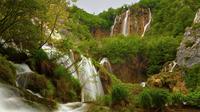Plitvice Lakes Private Guided Walking Tour
Plitvička Jezera, Croatia
Trip Type: Walking Tours
Duration: 6 hours
This tour will take you to the one of most beautiful European park, protected by UNESCO since 1979, as a World Natural Heritage. Plitvice Lakes National Park was founded in 1949 which makes it one of the oldest national parks in Southeast Europe.
More About This Activity All Walking Tours →
This tour will take you to the one of most beautiful European park, protected by UNESCO since 1979, as a World Natural Heritage. Plitvice Lakes National Park was founded in 1949 which makes it one of the oldest national parks in Southeast Europe.In Plitvice National Park, nature has created 16 lakes and connected them by amazing travertine waterfalls. The National Park covers 29685 hectares, where lakes take up to 200 hectares and forest covers the rest of the park. In this area you can encounter different species that have been living here since before the arrival of humans.
Starting point is at the north entrance of the park (Entrance 1). Sightseeing is circular and includes the Lower and Upper Lakes area, and a combination of walks and electric-boat rides, while the return to starting point will be mostly by panoramic train. Enjoy the beauty of the largest and most attractive waterfalls (“Great Waterfall”, “Veliki Prštavac” and “Mali Prštavac”), and countless smaller waterfalls, as well as the lakes.
The Plitvice lakes National Park belongs to Dinaric karst area and due to its specific geology, geomorphology and hydrology it truly is one of the most impressive karst entities in the world. Apart from dolomitic rock, mesosoic limestones with dolomite inserts prevail. The ratio between less porous or water-retaining dolomites and porous Jurassic limestone sediments in the karst has influenced the landscape of the overall area today. Specific hydrology properties of rock have enabled water retention on Triassic dolomite rocks, as well as canyon formation by water cutting through Cretaceous limestone deposits. Tufa barriers are a phenomenon enabling water to remain inside the lakes.
Starting point is at the north entrance of the park (Entrance 1). Sightseeing is circular and includes the Lower and Upper Lakes area, and a combination of walks and electric-boat rides, while the return to starting point will be mostly by panoramic train. Enjoy the beauty of the largest and most attractive waterfalls (“Great Waterfall”, “Veliki Prštavac” and “Mali Prštavac”), and countless smaller waterfalls, as well as the lakes.
The Plitvice lakes National Park belongs to Dinaric karst area and due to its specific geology, geomorphology and hydrology it truly is one of the most impressive karst entities in the world. Apart from dolomitic rock, mesosoic limestones with dolomite inserts prevail. The ratio between less porous or water-retaining dolomites and porous Jurassic limestone sediments in the karst has influenced the landscape of the overall area today. Specific hydrology properties of rock have enabled water retention on Triassic dolomite rocks, as well as canyon formation by water cutting through Cretaceous limestone deposits. Tufa barriers are a phenomenon enabling water to remain inside the lakes.
« Go Back

